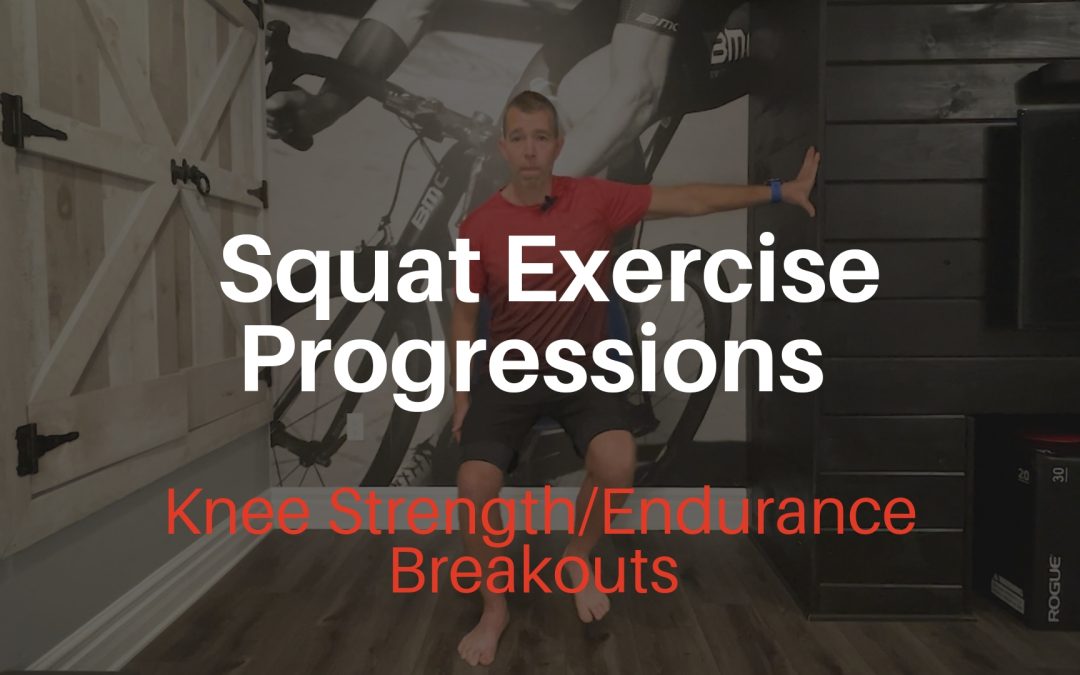In this article I’m going to review my go-to exercise progressions for the squat. But before we get into the exercises I want to just set-up a few things.
First off, let’s recognize that the squat is one of these exercises that often gets analyzed and debated to death. That’s partially due to the fact that there are many different applications of the squat. It’s widely used in both fitness and high performance training, and also with injury rehabilitation.
Additionally, there are so many different variables that can be considered or even manipulated with respect to how a squat can be performed.
For example, things like foot angle or positioning, trunk angle, squat depth, and knee and lower extremity alignment are all things that are talked about or even argued about with respect to how a squat can be or should be performed.
Let’s Keep Things Simple
To be clear, I’m not saying that these things never matter. But I would suggest that what it really comes down to is understanding what is the goal of the exercise in question.
And when it comes to the squat, I think there is also something to be said for keeping things simple. Especially when dealing with a population that is perhaps a little less knowledgeable about body mechanics or don’t have a great sense of body-awareness— which is often the population we are dealing with in a treatment or rehabilitation setting.
So with my squat progression I’m going to review here, let me provide some basic background about the squat exercise progressions I’m going to review here.
Key Application: When to Use and Why
So first, I’m typically going to use this progression with knee pain patients. Either as part of a general knee strength and endurance program, or to specifically target problems with knee extension.
In other words, the primary goal is to create basic loading progressions to target the knee extension mechanism.
So if that is my goal, and I want to simplify these exercises as much as possible for me and my patients, I’m not necessarily concerned here with specific trunk positioning, or making sure the glutes are activated – in fact, it’s really the quads I’m trying to focus on here.
That is why I am almost always going to prescribe this as a ball squat. And whenever necessary, I’m going to have the patient use the upper body for support and balance. This is my way to simplify the exercise and keep the focus on creating load through the knee and quadriceps group.
How Exercise Progressions Will Make Your Life Easier
The last thing I want to point out before we get to the exercises themselves is that this is a progressive exercise tract. So in other words, this is a group of the same or similar movements arranged in order of increased difficulty.
This allows us to easily find the right effort level for each patient. This is critical – if the exercise is too easy it won’t provide the desired adaptation stimulus. But if it’s too hard it will affect the quality of the exercise and may flare-up the condition.
So by thinking of exercises as tracts or progressions, it helps us to know where to start with each patient. But it also helps us to know where we’re going. As one exercise becomes too easy we can easily progress the patient or client to the next exercise in line.
And, as these progressions are just slight variations on an existing theme, the patient doesn’t have to learn a completely new movement.
Lastly, as each progression represents just a small increase in loading and physical demands it lowers the chances of flaring the condition.
The Exercises
Let’s move onto the exercises themselves. The 4 progressions were going to cover are:
- Basic Bilateral Ball Squat
- Ball Squat with Isometric Shift
- Eccentric Ball Squad
- Single Leg Ball Squat
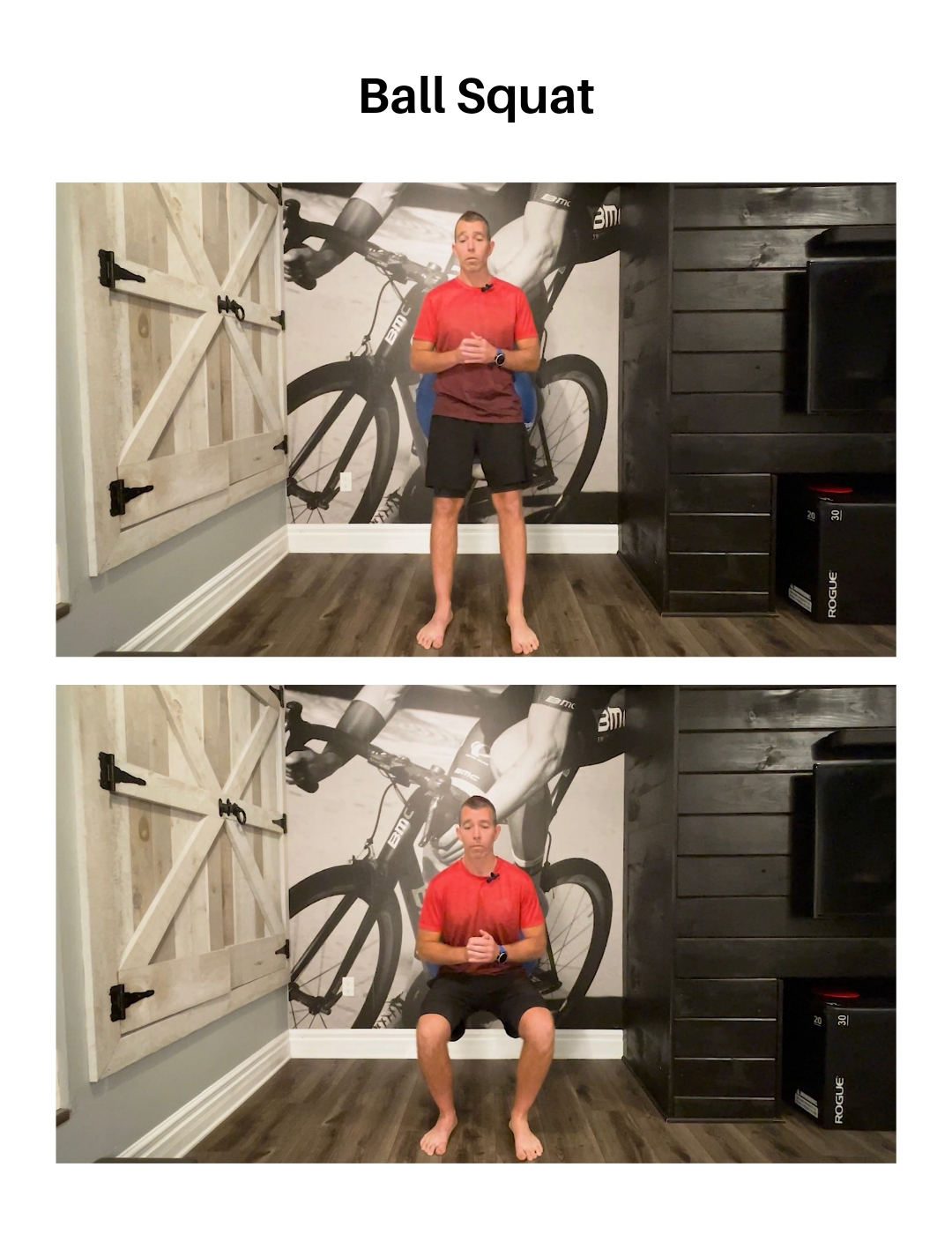
Here’s how to perform the Basic Ball Squat Exercise:
1) Place a large exercise ball against a wall, then lean into the ball with your lower back. Your feet should be under or even 1-2 inches ahead of your knees.
2) Squat down towards the floor. Go down as low as you can (try to get your thighs parallel) – but don’t force the motion. You should feel comfortable and in control for the entire motion.
3) Hold this bottom position for 3-5 seconds.
4) Now straight your knees and return to the starting/upright position.
5) Perform as many reps as you can until the muscles become tired — but be sure to keep good form and remain in control.
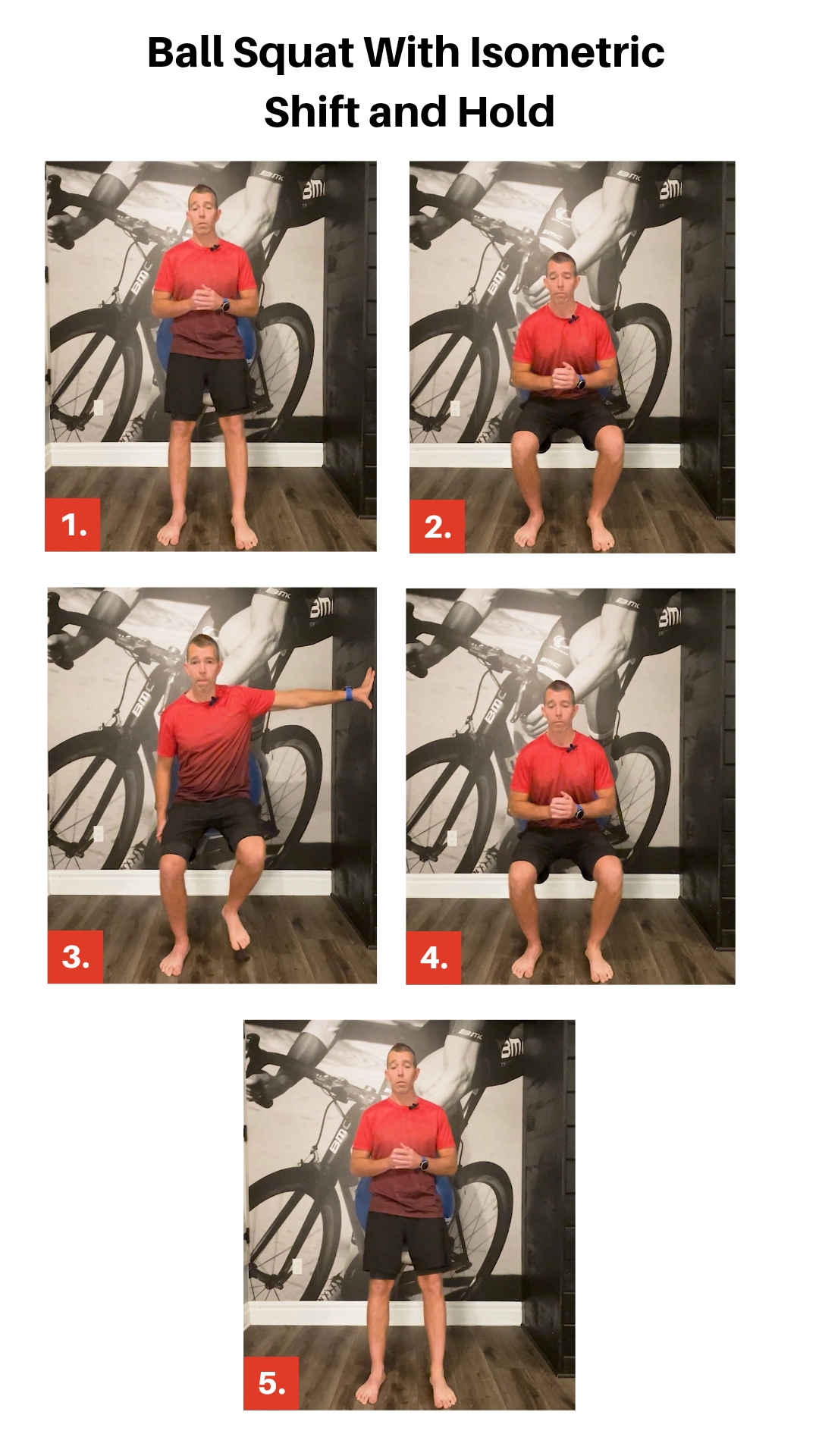
To perform the Ball Squat with Isometric Shift and Hold:
1) Place a large exercise ball against a wall, then lean into the ball with your lower back.
2) Squat down towards the floor. Squat down as low as you can (try to get your thighs parallel) – but don’t force the motion. You should feel comfortable and in control for the entire motion.
3) From this bottom position slowly lift one leg up off the floor so your weight is supported on just one leg. Hold this bottom position for 3-5 seconds.
4) Staying in this say squat position place your leg back on the floor so you are now standing on both legs.
5) Now straighten your knees and return to the starting/upright position.
*Perform as many reps as you can until the muscles become tired — but be sure to keep good form and remain in control.
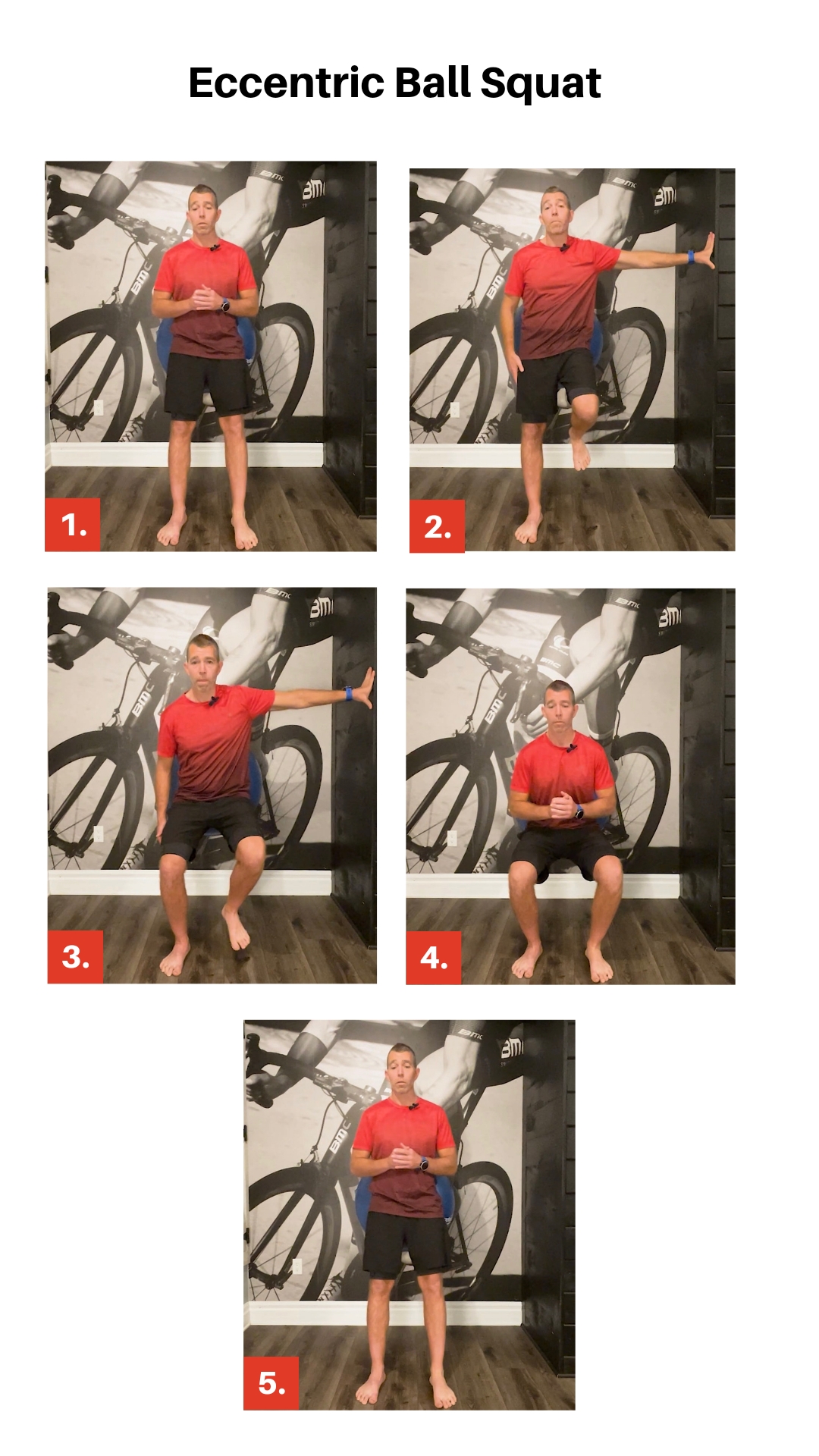
To perform the Eccentric Ball Squat:
1) Place a large exercise ball against a wall, then lean into the ball with your lower back. Your feet should be under or even 1-2 inches ahead of your knees.
2) Lift one leg off the floor so you are standing on a single leg. NOTE: Hold onto a wall or chair for support.
3) Slowly squat down towards the floor on one leg. Squat down as low as you can – but don’t force the motion. You should feel comfortable and in control for the entire motion. Hold this bottom position for 3-5 seconds.
4) While still in this squat position, place the other leg back on the floor. You should now be supported by both legs again.
5) Now straighten your knees and return to the starting/upright position.
*Perform as many reps as you can until the muscles become tired — but be sure to keep good form and remain in control.
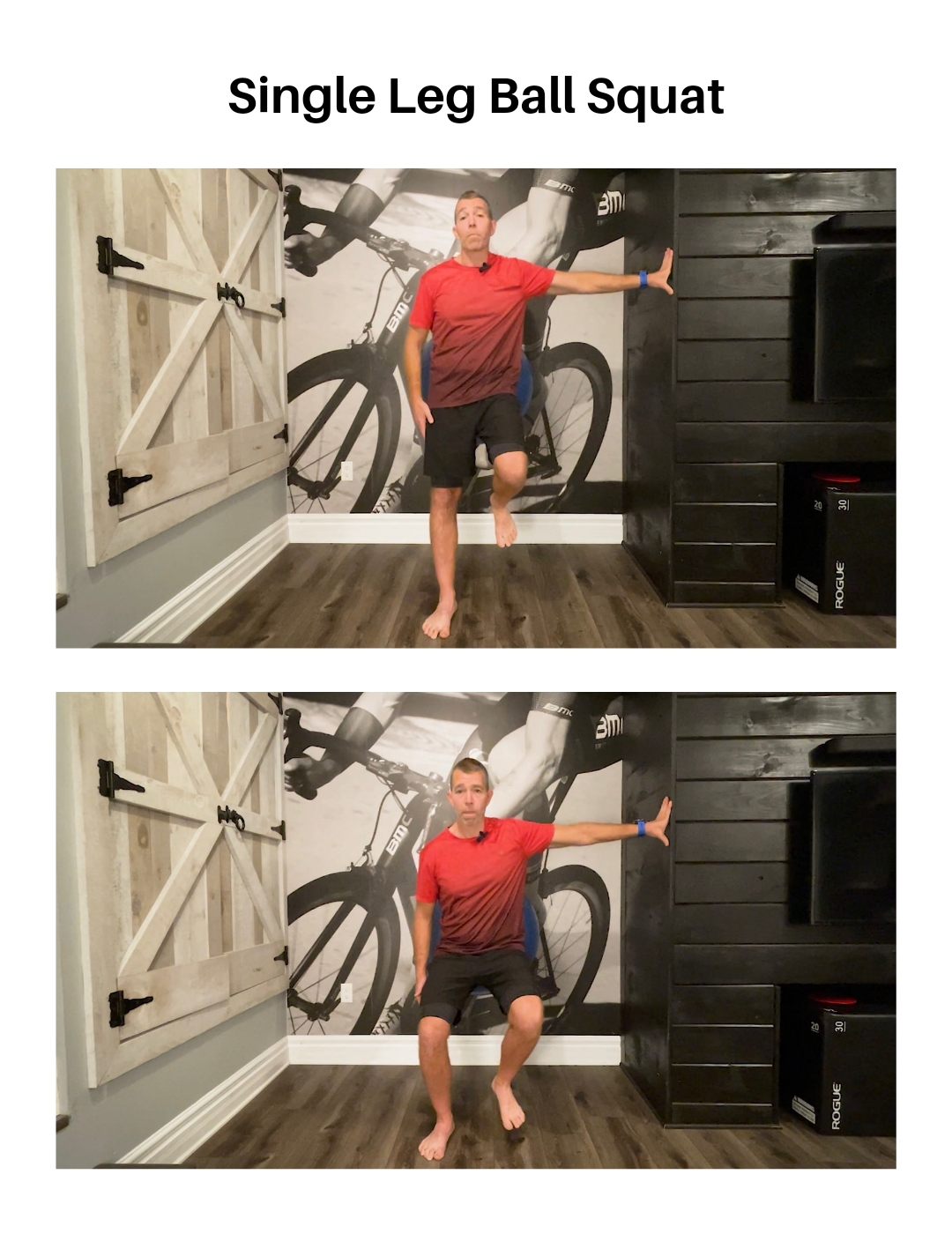
To perform the Single Leg Ball Squat:
1) Place a large exercise ball against a wall, then lean into the ball with your lower back. Your feet should be under or even 1-2 inches ahead of your knees.
2) Lift one leg off the floor so you are standing on a single leg. NOTE: Hold onto a wall or chair for support.
3) Slowly squat down towards the floor on one leg. Hold this bottom position for 3-5 seconds.
4) Now straighten your knees and return to the starting/upright position.
*Perform as many reps as you can until the muscles become tired — but be sure to keep good form and remain in control.
Squat Exercise Progressions: Programming and Progression Criteria
So now that we’ve reviewed the exercises themselves, let’s take a moment to talk about programming and progression criteria.
Sets and Reps
First, as we’re trying to target strength, we need to make sure we’re creating a sufficient exercise challenge – we need to really fatigue the muscles. So here we will typically prescribe 3-5 sets per session.
But I don’t typically prescribe a set number of reps. Instead, I have patients perform exercises to fatigue. I tell patients to perform as many reps as they can, but not to go past the point where their form breaks down or they feel they are no longer in full control of the movement.
I also want my patient to keep track of their numbers – because that is largely how I am going to determine when they need to progress to the next exercises, or in some cases when we may need to regress.
What I am typically looking for here is I want each patient to be able to work within sets of 8-15 repetitions. If the exercises flare up the symptoms, or they can’t perform at least 8 repetitions I will likely regress the exercises. Likewise, when they can easily perform 12-15 repetitions I will move them to the next progression.
Frequency
In terms of frequency, remember we also need to build in adequate recovery. So we need a minimum of 1 day between exercises sessions. Which means I’m going to have them perform these exercises 2-3x/week.
I should also point out here that these exercises aren’t going to be the only ones they are performing. So within this strength session these squat progression may be part of a general knee strengthening routine or circuit.
Planning A Week
Lastly, let’s talk about planning and programming for a week. While these strength exercises are important, these patients will also be performing mobility and control exercises – which are typically done on a daily basis.
For our example here, as we’re typically using this squat progression for our knee pain patients, I will also have these patients performing our Basic Knee Mobility and Control Movement Sequence 1x/day, or maybe even 2x/day. Then, 2-3x/week I will also plug in our strength-endurance exercises.
Make Exercises Prescription Easier For You And Your Patients
And just as one last reminder, remember if you are a MRC subscriber and you use our exercise prescription software, you can find this progression in our Exercise Library. You can either search for each exercise by name in the Library itself, or you can find it in the Exercise Groups section under the title: Knee Strength Progression: Ball Squat Progression

